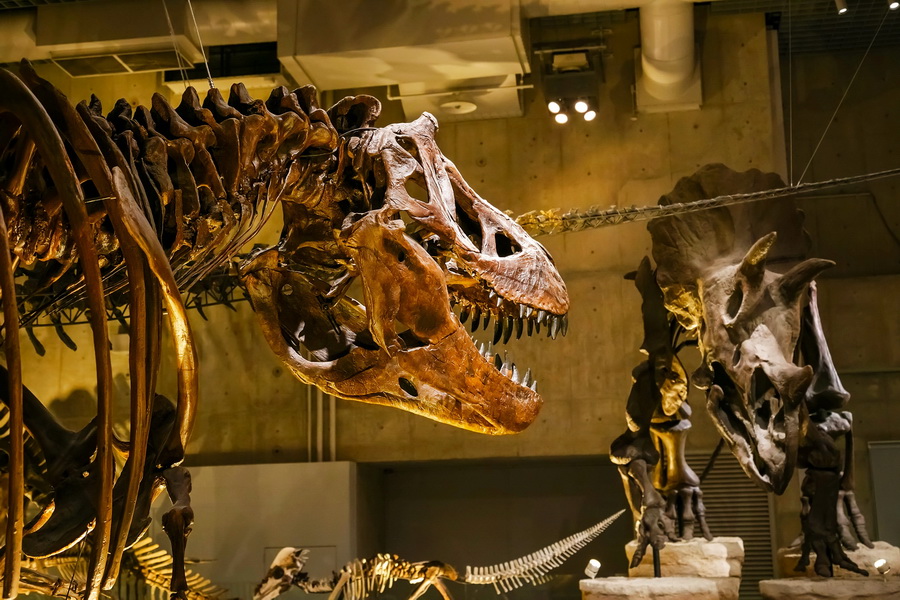
National Museum of Nature and Science (Kokuritsu Kagaku Hakubutsukan, 国立科学博物館) – a museum located in Ueno Park, Tokyo. The museum features exhibitions focused on the history of science in Japan, extending up to the Meiji era. It houses the taxidermied remains of the legendary dogs Hachiko, Taro, and Jiro. Additionally, a life-sized model of a blue whale and a steam locomotive are displayed outside.
History
National Museum of Nature and Science was founded in 1877, making it one of the oldest science museums in Japan. The museum was created with the aim of promoting scientific knowledge and the study of nature, and with the intention of playing a key role in the educational and cultural life of the country. Its creation was part of the evolution of the Japanese government during the Meiji era (868 - 1912), when Japan actively borrowed scientific and technological advances from Western countries.
Originally, the museum was part of a broader initiative to establish a National Museum that would encompass various sections dedicated to archaeology, art, and culture. However, the National Museum of Nature and Science soon became an independent institution, focusing on natural sciences, paleontology, ecology, and other areas related to the natural world.
During its first few decades, the museum actively expanded its collections. Many of these were acquired through international expeditions and exchanges with foreign scientific institutions, facilitating the introduction of Western scientific knowledge in Japan. The museum's collections began to include rare fossils, biological specimens, and examples of Japanese flora and fauna.
Today, the National Museum of Nature and Science serves as a vital scientific and educational center and stands as one of the most popular tourist attractions in Tokyo. It draws millions of visitors each year, offering a unique opportunity to learn about nature, the history of the Earth, and the achievements of human science and technology.
Exhibitions in Museum
The National Museum of Nature and Science in Tokyo offers a diverse range of exhibitions that cover a wide array of topics, from paleontology and biology to technology and space. These exhibits are not only engaging and informative, but they also allow visitors to gain a deeper understanding of how science develops and its connection to our everyday lives.
Nature and Ecology. The exhibition dedicated to nature and ecology introduces visitors to the rich plant and animal life of Japan. The hall features rare and unique species of flora and fauna characteristic of Japanese ecosystems, including forests, mountains, rivers, and coastal areas. Here, visitors can observe both modern and extinct species, as well as learn about the importance of environmental conservation.
Special emphasis is placed on Japanese ecosystems and rare animal species, such as Japanese macaques, black bears, and endangered bird species. The collection also includes models of natural landscapes that help visualize the interactions between various natural systems.
Dinosaurs and Ancient Life. One of the most exciting exhibitions is the collection dedicated to dinosaurs and ancient life. The museum takes pride in its fossil collection, which showcases various species of dinosaurs that once inhabited the Earth. This exhibition is among the most visited and popular attractions for both children and adults.
Visitors can see reconstructions of dinosaur skeletons, such as Tyrannosaurus rex and Diplodocus, as well as other ancient creatures like mammoths and prehistoric reptiles. The models and exhibits provide a unique opportunity to trace the evolution of life on the planet and learn about how dinosaurs influenced the development of ecosystems.

Technology and Innovation. The exhibition dedicated to scientific achievements and technology narrates the development of scientific ideas and technologies in Japan. The display covers a wide range of topics, from early Japanese inventions to modern technologies such as robotics, automobiles, and high-speed trains.
One of the central displays features Japanese advancements in transportation, including a model of the famous Shinkansen (bullet train) and various engineering innovations. The exhibits also highlight automated systems, robots, and digital technologies that are actively being developed in Japan.
Space and Astronomy. The museum offers an interactive exhibition dedicated to space exploration and astronomy. The hall includes models of spacecraft, satellites, and telescopes, as well as various astronomical instruments used for observing the cosmos.
Special attention is given to the study of the Solar System, planets, and stars, as well as Japan's achievements in space research. Visitors can learn about Japanese satellites, scientific missions, and ongoing projects.
Interactive Exhibitions. The museum actively employs modern technology to create interactive displays. Visitors can not only view exhibits but also participate in scientific experiments, conduct research, and solve challenges. This is particularly appealing to children and family visitors, as it allows them to engage with the principles of scientific work hands-on.
For children, the museum offers various play zones where they can interact with scientific phenomena through games and experiments, making the learning process both entertaining and accessible.
Temporary Exhibitions. In addition to its permanent displays, the museum regularly hosts temporary exhibitions that often focus on specific topics such as new advancements in biotechnology, artificial intelligence, robotics, and the history of scientific discoveries. These exhibitions change several times a year, providing visitors with new opportunities to expand their knowledge.
Temporary exhibitions frequently include international projects, showcasing artifacts from other museums around the world in Tokyo, which allows both Japanese visitors and foreign tourists to familiarize themselves with global achievements in science and culture.
How to Get to the National Museum of Nature and Science
The National Museum of Nature and Science is located near Ueno Station, within Ueno Park. Ueno Station is on the JR Yamanote Line, just four stops from Tokyo Station. Exit the park at Ueno Station, and it takes less than five minutes to walk to the museum entrance.
Visiting Tips for National Museum of Nature and Science
- Photography: Flash photography is prohibited in the museum.
- Storage Facilities: Large bags or backpacks are not allowed. Convenient storage lockers are available for guests.
- Language Support: For international tourists, the museum provides information in English, including audio guides and guided tours.
- Visiting with Children: The museum is an excellent place for family visits. Children are likely to be interested in the interactive exhibits and can participate in various scientific activities.
- Time Recommendations: To fully enjoy all the exhibitions, it is advisable to allocate about 2-3 hours for your visit to the museum.
Opening hours:
Open: Every day 9:00-17:00
Closed: Monday, New Year's holidays.
If a scheduled closing falls on a public holiday, the facility will remain open on the holiday and close the next day.
General admission: 630 yen

